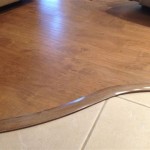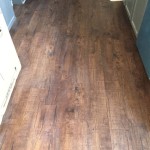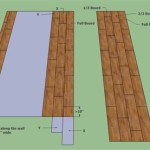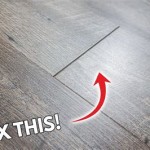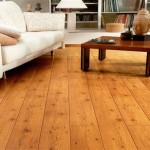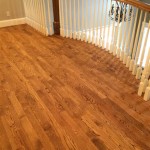How Do You Prepare Plywood Subfloor For Vinyl Plank Flooring?
Installing vinyl plank flooring can significantly enhance the aesthetics and functionality of a space. However, the success of this installation hinges heavily on the preparation of the subfloor, particularly when that subfloor is plywood. Proper preparation ensures a smooth, stable, and durable surface for the vinyl planks, preventing issues such as unevenness, buckling, and premature wear. This article details the essential steps involved in preparing a plywood subfloor for vinyl plank flooring installation.
Plywood is a common subfloor material due to its strength, affordability, and ease of installation. It provides a solid base for various types of flooring, including vinyl plank. However, plywood is susceptible to moisture damage, warping, and imperfections that can telegraph through the vinyl plank flooring if not properly addressed. A meticulous preparation process mitigates these risks and contributes to a professional and long-lasting finish.
Inspection and Assessment of the Plywood Subfloor
The initial step in preparing a plywood subfloor is a thorough inspection and assessment of its current condition. This involves identifying and addressing any existing issues that could compromise the integrity and stability of the finished floor. The inspection should encompass several key areas, including moisture levels, structural integrity, surface imperfections, and fastener security.
Moisture Levels: Elevated moisture levels in the plywood subfloor can lead to warping, mold growth, and adhesive failure. Using a moisture meter, measure the moisture content of the plywood in several locations throughout the room. The acceptable moisture level typically depends on the specific vinyl plank flooring being installed and should be within the manufacturer's recommended range. Exceeding this range necessitates identifying and rectifying the source of the moisture. This may involve repairing leaks in the roof, plumbing, or foundation, or improving ventilation in the room. Allow the plywood to dry completely before proceeding with further preparation. Dehumidifiers and fans can expedite this drying process.
Structural Integrity: Inspect the plywood sheets for signs of damage, such as delamination, rot, or warping. Delamination refers to the separation of the plywood layers, while rot indicates decay caused by moisture and fungal growth. Warping refers to the distortion of the plywood sheets, creating an uneven surface. Any damaged sections of plywood must be replaced with new sheets of the same thickness and grade. Ensure the replacement plywood is properly fastened to the floor joists.
Surface Imperfections: Examine the surface of the plywood for imperfections such as gouges, scratches, dents, and knots. These imperfections can telegraph through the vinyl plank flooring, creating an uneven and unsightly appearance. Small imperfections can be filled with a suitable patching compound designed for wood floors. Larger imperfections may require more extensive repairs, such as sanding or the application of a self-leveling compound.
Fastener Security: Ensure that the plywood sheets are securely fastened to the floor joists. Loose or protruding fasteners can cause squeaking and instability. Inspect all screws or nails and tighten or replace any that are loose or damaged. If necessary, add additional fasteners to reinforce the subfloor. Countersink any protruding fasteners to create a flush surface.
Cleaning and Preparing the Subfloor Surface
Once the inspection and assessment are complete, the next step is to thoroughly clean and prepare the subfloor surface. This involves removing any debris, contaminants, and residues that could interfere with the adhesion of the vinyl plank flooring. A clean and properly prepared surface is essential for a successful and long-lasting installation.
Removing Debris and Contaminants: Begin by sweeping or vacuuming the entire subfloor surface to remove any loose debris, such as dust, dirt, and wood shavings. Pay particular attention to corners and edges, where debris tends to accumulate. For stubborn debris, use a scraper or putty knife to dislodge it. After sweeping or vacuuming, use a damp mop to clean the surface. Ensure the mop is only slightly damp to avoid saturating the plywood. Use a mild detergent solution to remove any grease, oil, or stains. Rinse the surface with clean water and allow it to dry completely before proceeding to the next step.
Sanding the Subfloor: Sanding the subfloor is essential for creating a smooth and even surface. Use a floor sander with a medium-grit sandpaper (e.g., 80-grit) to sand the entire subfloor. Focus on removing any remaining imperfections, such as raised grain, unevenness, and residual adhesive. After sanding with the medium-grit sandpaper, switch to a fine-grit sandpaper (e.g., 120-grit) to smooth the surface further. This will create a more refined surface that is ideal for vinyl plank flooring installation. Vacuum the subfloor thoroughly after sanding to remove any residual dust.
Repairing Imperfections with Patching Compound: After sanding, inspect the subfloor for any remaining imperfections, such as small holes, cracks, or gouges. Fill these imperfections with a wood patching compound designed for flooring applications. Follow the manufacturer's instructions for applying the patching compound. Allow the patching compound to dry completely before sanding it smooth. Use a fine-grit sandpaper to blend the patched areas with the surrounding surface. Vacuum the subfloor again to remove any residual dust.
Applying a Self-Leveling Compound (Optional): In cases where the subfloor is significantly uneven or has numerous imperfections, a self-leveling compound may be necessary. Self-leveling compounds are designed to create a perfectly level surface, which is ideal for vinyl plank flooring installation. Follow the manufacturer's instructions for mixing and applying the self-leveling compound. Ensure the compound is evenly distributed throughout the room. Allow the compound to dry completely before proceeding to the next step. This may take several hours or even days, depending on the specific product and environmental conditions.
Ensuring a Secure and Stable Subfloor
The final step in preparing a plywood subfloor for vinyl plank flooring is to ensure that it is secure and stable. This involves addressing any remaining structural issues and reinforcing the subfloor as needed. A secure and stable subfloor is essential for preventing movement, squeaking, and other issues that could compromise the integrity of the finished floor.
Reinforcing the Subfloor with Screws: To further secure the plywood sheets to the floor joists, consider adding additional screws. Use wood screws that are long enough to penetrate the plywood and the joists. Space the screws evenly throughout the subfloor, typically every 6 to 8 inches along the joists. Countersink the screws slightly to ensure they are flush with the surface of the plywood.
Addressing Squeaks: Squeaks in the subfloor are often caused by loose fasteners or movement between the plywood and the joists. To eliminate squeaks, locate the source of the squeaking and tighten or replace any loose fasteners. You may also need to add shims between the plywood and the joists to eliminate any gaps. In some cases, it may be necessary to apply construction adhesive between the plywood and the joists to prevent movement.
Installing an Underlayment (Optional): While not always necessary, installing an underlayment between the plywood subfloor and the vinyl plank flooring can provide several benefits. Underlayment can help to cushion the flooring, reduce noise transmission, and improve the insulation of the room. Choose an underlayment that is specifically designed for use with vinyl plank flooring. Follow the manufacturer's instructions for installing the underlayment. Typically, the underlayment is rolled out over the subfloor and secured with tape or staples.
Final Cleaning and Inspection: Before installing the vinyl plank flooring, perform a final cleaning and inspection of the subfloor. Vacuum the surface thoroughly to remove any remaining dust or debris. Inspect the subfloor for any imperfections or issues that may have been overlooked. Address any remaining concerns before proceeding with the flooring installation. A clean, smooth, and stable subfloor is essential for a successful and long-lasting vinyl plank flooring installation.
By following these steps meticulously, the preparation of a plywood subfloor for vinyl plank flooring ensures a professional-quality installation that enhances the longevity and aesthetic appeal of the finished floor. Each step contributes to a solid foundation, minimizing potential issues and maximizing the value of the flooring investment.

How To Prep Wood Subfloor For Luxury Vinyl Plank Flooring Beginners Fix High And Low Spots

How To Prep Wood Subfloors For Vinyl Plank Flooring

How To Prepare The Floor For Vinyl Plank Installation

Complete Guide Underlayment For Vinyl Sheet Flooring

Floor Prep For Beginners Installing Vinyl Plank

Preparing Your Sub Floor For Luxury Vinyl Plank Flooring Floors Paws

How To Prep Your Sub Floor For Luxury Vinyl Flooring

How To Prep Floors For Luxury Vinyl Planks Nynr Refresh Challenge Casa Watkins Living

Installing Vinyl Floors A Do It Yourself Guide The Honeycomb Home

How To Prep A Subfloor Lowe S
Related Posts

